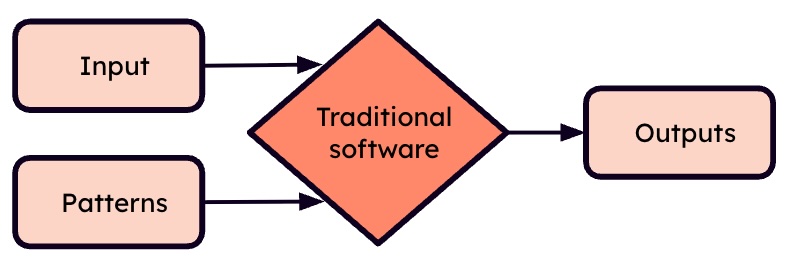The AI Product Manager: Redefining how we build and learn

AI is transforming how teams build, learn, and make decisions.
But beneath the hype, there’s still confusion about what AI actually changes in product work — and what still depends on human judgment.
This post breaks down what AI really means for product leaders: the new responsibilities, skills, and ethical guardrails shaping this next chapter of product management.
It’s based on my own experience building AI-powered products — the wins, the missteps, and everything in between.
Here’s what we’ll cover
- Traditional Software vs. AI Software
- Traditional PM vs. AI PM — how the role shifts
- The essential skills every AI PM needs
- Translating business problems into AI solutions
- The risks, responsibilities, and ethics of building with AI
The shift from traditional to AI software
For decades, building software followed a simple rule: We defined the logic, wrote the PRD, worked with engineers and designers — and built it exactly as specified.
You had an input, and the output was always the same.
If a user entered X, the system returned Y — every time.
Think of a spreadsheet: you define a formula, and the computer executes it again and again.The logic lives entirely in the code you write.
That’s why traditional software is deterministic — same input, same output, predictable results.

AI software, on the other hand, is data-driven. It learns patterns from the data it’s trained on and makes predictions based on that learning.
The same input can produce different outputs depending on what the model has learned and how confident it is in its prediction.
Take TikTok’s feed, for example: within seconds, the algorithm reshapes what you see based on engagement predictions. How you scroll, what you watch, and how long you linger continuously change your feed in real time.
AI software is probabilistic — it predicts rather than prescribes.
And when I say “AI software,” I mean everything from traditional machine learning models to today’s foundation models — including Generative AI (text, image, audio, video) and LLMs.

How this changes the role of the Product Manager
A traditional product manager works in a deterministic world — clear logic, fixed inputs, predictable outcomes. You define requirements, prioritize features, and measure success by user behavior and business metrics.
AI changes that.
In AI-driven products, outcomes depend on data, not just code. The same input can produce different results — and the PM’s role evolves accordingly.
Think of it this way:
- A traditional PM defines the logic.
- An AI PM defines the learning loop.
In traditional software, you’re responsible for what happens.
In AI software, you’re responsible for how and from what the system learns — and for understanding its behavior through AI evaluations (AI evals).
AI evals help you see where the model performs well, where it fails, and how to improve it.
You don’t manage features — you manage systems that learn and evolve.
That shift changes everything: how you build, how you measure success, and how you communicate uncertainty.
The essential skills of an AI Product Manager
AI product management isn’t about writing code or training models — it’s about connecting data, models, and user experience to deliver meaningful outcomes.
Here’s what matters most:
Data literacy — the non-negotiable skill
You don’t need to be a data scientist, but you must understand how data quality, labeling, and bias affect model performance.
Ask:
- Do we have the right data to solve this problem?
- How representative is it?
- What metric reflects real user value — not just model accuracy?
While building one of our AI products, we ran into an interesting challenge during the data labeling phase — three experts labeled the same dataset and agreed on labels for only 23% of the samples. It was a good reminder of how much human interpretation shapes AI systems.
AI evals — turning feedback into learning
Once your system is in development or already in production, AI evals help you measure whether it’s doing what you intended — and, more importantly, how well it performs and where it falls short.
AI evals are a structured process for assessing how an AI system performs against defined goals. They replace guesswork with a repeatable method: review model behavior, identify where it struggles, and feed those insights back to improve performance.
Because AI doesn’t behave the same way twice, evals give you visibility into what’s improving, what’s regressing, and what’s drifting.
Great AI PMs define what “good” looks like, build evals that catch issues early, and make learnings part of product conversations — not just data reports.
Over time, evals become the heartbeat of iteration, turning model performance into user-centric insight.
Experimentation mindset
AI product work is less about delivering features and more about testing hypotheses.
You speak in experiments, not tasks:
- “Can we predict X with Y accuracy?”
- “Does this model outperform random chance?”
AI PMs thrive on iteration.
They set clear metrics for business and user outcomes, and work with data scientists to define precision, recall, and F1 — so everyone (data science, product, and engineering) speaks the same language.
Communication and alignment
Not everyone around you understands AI — and that’s part of your job.
You bridge business and data, translating technical uncertainty into actionable decisions.
The best AI PMs don’t just share results — they tell the story of learning, keeping teams aligned on what’s working and why.
Translating business problems into AI solutions
The biggest mistake teams make is trying to add AI to a product instead of solving a real customer problem.
A recent MIT study found that 95% of generative AI projects in businesses fail to deliver measurable results — whether in revenue growth or productivity gains.
That gap highlights the critical role of the product manager. It’s not enough to build with AI; you need to enable your product to actually create customer value.
If your AI product doesn’t solve a real problem for the customer, it won’t survive — no matter how advanced the technology is.
It always starts with a business question, not a model.
Ask yourself:
- What problem are we solving, and who’s experiencing it?
- Do we have the data to solve it effectively for those users?
For example, in online identity verification, ask whether simple logic (if/then rules) is enough — or whether machine learning is required to recognize faces and handle edge cases like poor lighting, glasses, or even identical twins.
Once you know AI is the right approach, define what “good enough” looks like.
An AI MVP isn’t about perfection — it’s about proving your data can reliably solve the problem.
Say you’re building toxic behavior detection using an LLM.
You don’t need a full system. Start by prompting your chosen model (ChatGPT, Claude, etc.), build a lightweight prototype, and observe how it flags toxic content. That prototype becomes the foundation for your next iteration.
The ethical compass: Building trust in AI products
AI doesn’t know right or wrong — only patterns.
As product leaders, we decide what those patterns mean.
Fairness: Who could this model disadvantage?
Healthcare, hiring, or lending systems can easily reinforce bias if trained on incomplete data.
Transparency: Can users understand an AI decision?
AI-driven systems should make their logic interpretable — not hidden behind a black box.
Accountability: What happens when it fails?
Define ownership for model drift, errors, and retraining triggers. Build human fallback systems.
Ethics in AI isn’t compliance — it’s strategy.
It’s how teams build trust and long-term adoption in systems that learn and make decisions over time. Trust is earned through clarity and control, not opacity and speed.
Where to start if you’re transitioning
If you’re a product manager moving into AI, start where you are.
Find an AI-adjacent problem in your current product — something that could be improved through prediction, personalization, or automation.
You don’t need to train models to get started; you need to understand how data becomes decisions.
Spend time learning how your product uses data today, what signals matter, and where your team’s knowledge gaps are.
Work closely with your data or analytics team. Ask:
- What patterns are we already collecting?
- What could we predict or automate with what we have?
And invest in structured learning — programs, mentorship, or courses that help you connect product thinking with AI principles.
AI product management isn’t about becoming technical — it’s about becoming data fluent, hypothesis-driven, and ethically aware.
Bringing AI into product work — with clarity and purpose
At Chovik, we help teams and product leaders make sense of where AI truly fits — whether you’re building an AI-powered product from the ground up or learning how to use AI to make smarter product decisions.
If your team is exploring how AI can enhance product work — or figuring out how to build an AI product — let’s talk.



